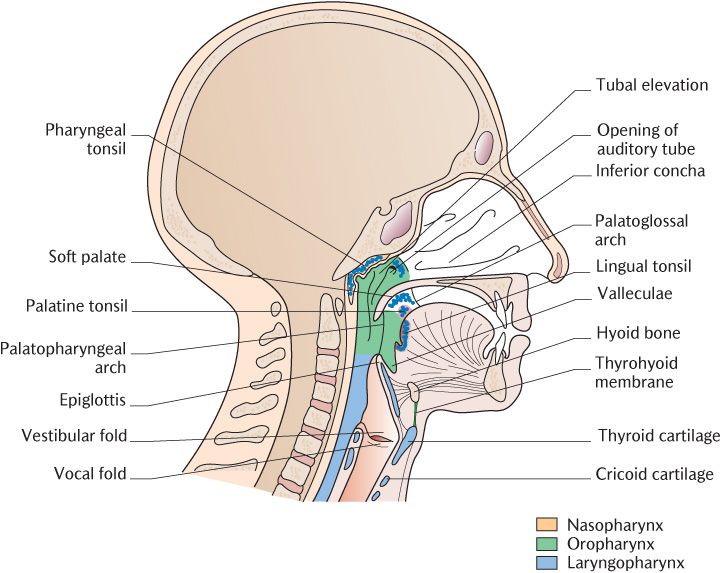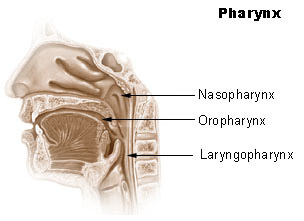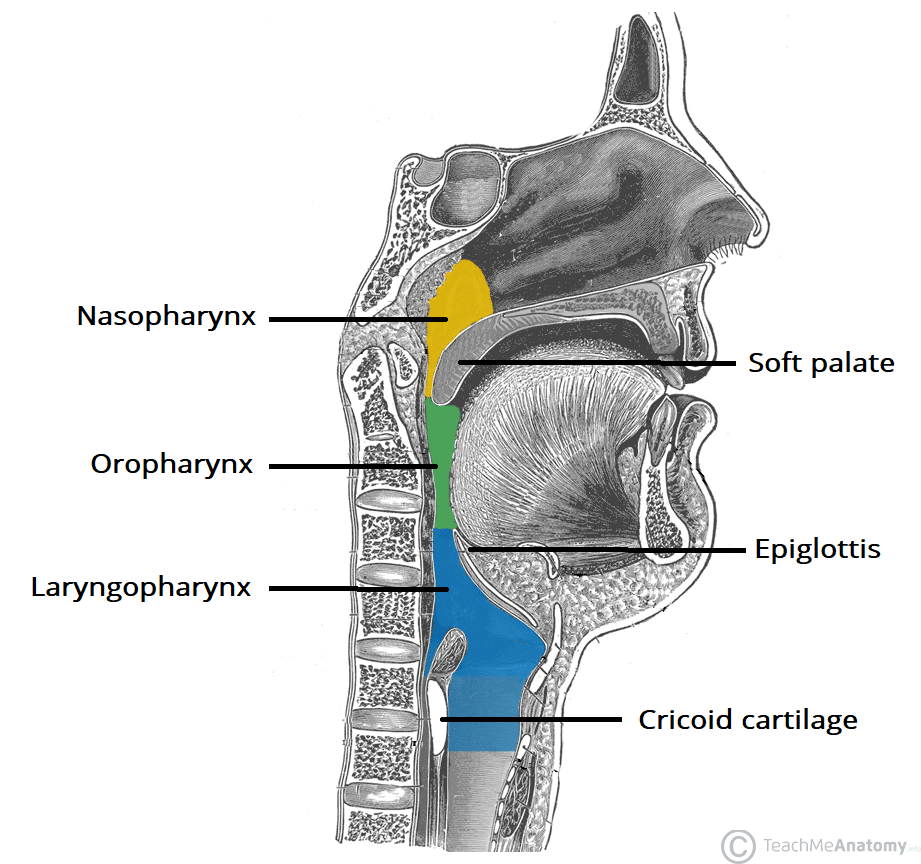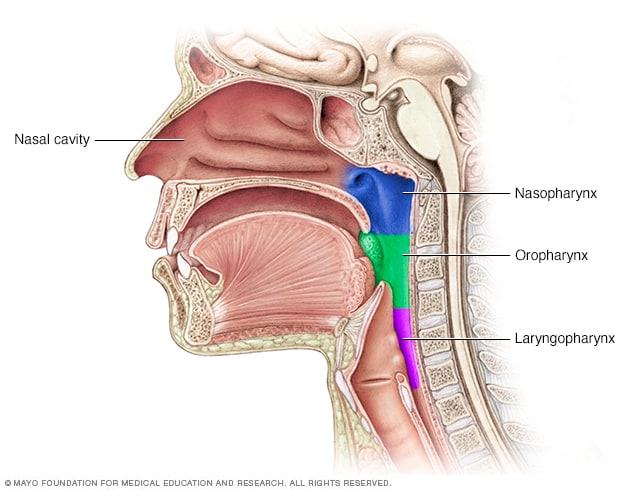The roof posterior wall of the nasopharynx form a continuous sloping surface that lies under the body of the _______ _______ part of the _______ bone. The curving superior and posterior walls are attached to the axial skeleton but the lateral walls are flexible and muscular.

28 The Pharynx Soft Palate And Larynx Pocket Dentistry
It is found in vertebrates and invertebrates though its structure varies across species.

. The pharynx runs from the nostrils to the esophagus and the larynx. Posterior to the pharynx is the cervical part of the spine the necks deep muscles the cervical fascia layer and retropharyngeal space. The pharynx is the part of the throat behind the mouth and nasal cavity and above the oesophagus and trachea.
The space between the tongue and palatoglossal and palatopharyngeal arches is called the tonsillar fossa sinus and it is where the palatine tonsils are located. The lowermost portion of the pharynx is known as the laryngeal. The pharynx is the cavity which connects the nose and the mouth to the larynx and the esophagus.
The pharynx has three anatomical parts. In the nasopharynx a mass of ______ tissue is embedded in the mucous membrane here is termed the _______. Pars oralis pharyngis TA oral part of pharynx oral pharynx.
The oral cavity and oral pharynx are divided into the following specific areas. The main features of pharynx. The pharynx extends from the base of the skull down to the inferior border of the cricoid cartilage around the C6 vertebral level.
The raphe is visible as a tissue fold in the mouth that runs from the distal part of the maxillary tuberosity to the mandibular mylohyoid ridge. The posterior constricted part of the fauces is called the isthmus of the fauces and it is a gate between the oral cavity and oropharynx. The pocket-like part of the mouth that is framed on the inside by the gums and teeth and on the outside by the cheeks and lips is called the oral vestibule.
When food enters the pharynx involuntary muscle contractions close off the air passageways. And posterior tonsillar pillars the glossotonsillar sulci the pharyngeal tonsils and the lateral and posterior walls. This band of tissue runs in the posterior wall of the pharynx.
The pharynx is the part of the digestive system situated posterior to the nasal and oral cavities and posterior to the larynx. Posteriorly the soft palate ends in a projection called the uvula. The nasal pharynx is the one that is present behind the nasal cavity.
The oropharynx is the portion of the pharynx that is posterior to the oral cavity. The pharynx plural. The pharynx is the part of the digestive system situated posterior to the nasal and oral cavities and posterior to the larynx.
This part of the pharynx continues completely to the throat and goes till the hyoid bone can be seen. Middle portion of the pharynx posterior to mouth bounded by soft palate superior portion of the epiglottis innervation by. The anterior aponeurotic portion is.
It locates at the first and second cervical vertebrae level C1-2 posterior and inferior to the nasal cavity. It is divided into 3 sections the nasopharynx oropharynx and. The portion of the pharynx that lies posterior to the mouth.
It extends from the uvula which is the fleshy piece of tissue that hangs at the back of the throat to the hyoid bone which sits in the neck between the jawbone or mandible and the thyroid cartilage. The digestive and respiratory systems share the pharynx. It inserts into a raphe posteriorly that connects the two pharyngeal constrictors to each other known as the pharyngeal raphe.
Pharynges is the part of the neck and throat situated immediately posterior to behind the mouth and nasal cavity and cranial or superior to the esophagus larynx and. Moving farther into the mouth the opening between the oral cavity and throat oropharynx is called the. A tongue is usually divided into two sections.
Along the lateral wall goes blood vessels and nerves. Superior to inferior they are- nasopharynx oropharynx and laryngopharynx. It extends between the posterior nasal apertures and the entrances to the trachea and esophagus.
The nasopharynx runs from the back of the nasal cavity down the posterior aspect of the soft palate. During swallowing the soft palate and uvula move upward to direct food away from the nasal cavity and into the oropharynx. Oropharynx ōrō-faringks TA The portion of the pharynx that lies posterior to the mouth.
The pharynx throat is involved in both digestion and respiration. Laryngeal pharynx It is the lowermost part of the pharynx from epiglottis and continues to the oesophagus. It is continuous above with the nasopharynx via the pharyngeal isthmus and below with the laryngopharynx.
The posterior tongue or the pharyngeal part is the base of the tongue that is located farthest back in the mouth close to the opening of the throat. The pharynx connects the nose mouth and throat. Laryngopharynx voice box lowest portion of the pharynx extends from epiglottis to inferior aspect of cricoid cartilage inferior to interarytenoid notch Posteriorly bounded by vertebral bodies C4-C6.
Nasal pharynx As the name suggests it is the part of the pharynx that is present posterior to the nasal cavity. The pharynx consists of both. The tongue manipulates food in the mouth and is used in speech.
The posterior pharynx can be seen at the base of the tongue when the mouth is opened widely. When the soft palate is relaxed its anterior surface is concave and its posterior surface is convex. The flap of cartilage called the epiglottis stops food from entering the larynx.
Vermilion surface mucosal lip labial mucosa upper and lower form the upper and lower anterior wall of the oral cavity. The pharynx extends from the base of the skull down to the inferior border of the cricoid cartilage around the C6 vertebral level where it becomes continuous with the esophagus. The pharynx carries food and air to the esophagus and larynx respectively.
The posterior portion the soft palate is skeletal muscle and connective tissue. It is divided into 3 sections the nasopharynx oropharynx and laryngopharynx. It receives food and air from the mouth and air from the nasal cavities.
Oral pharynx It is the part behind the oral cavity and continues in the throat till hyoid bone. The oral pharynx is the portion of the pharynx that is situated right on the posterior side of the oral cavity. The part of the tongue that is able to move is named the anterior tongue and the immobile base is called the posterior tongue.

Pharynx Oral Cavity And Swallowing Flashcards Quizlet

The Pharynx Flashcards Quizlet

Anatomy Of The Pharynx And Esophagus Osmosis

Pharynx Definition Location Function Structure Facts Britannica



0 comments
Post a Comment